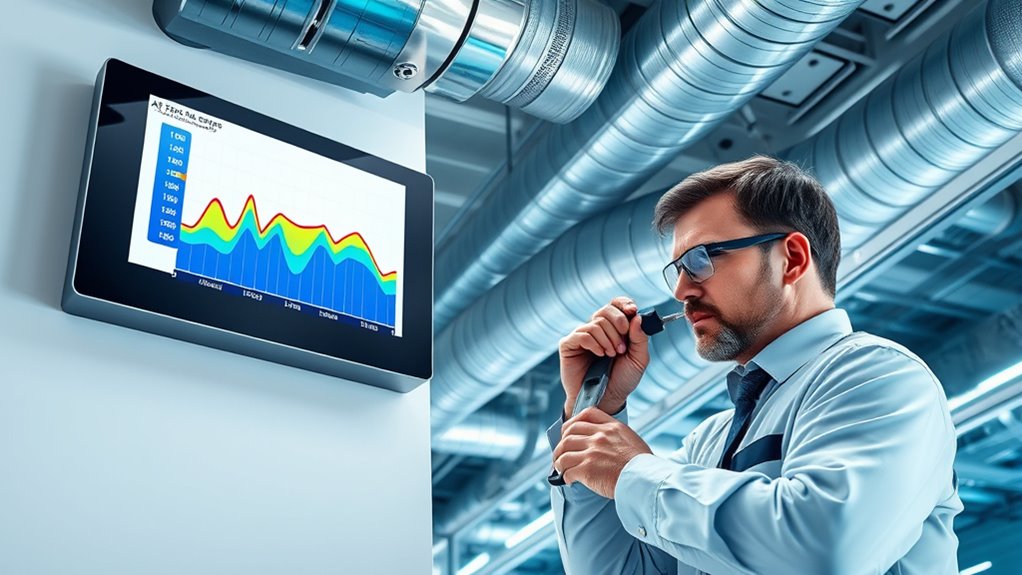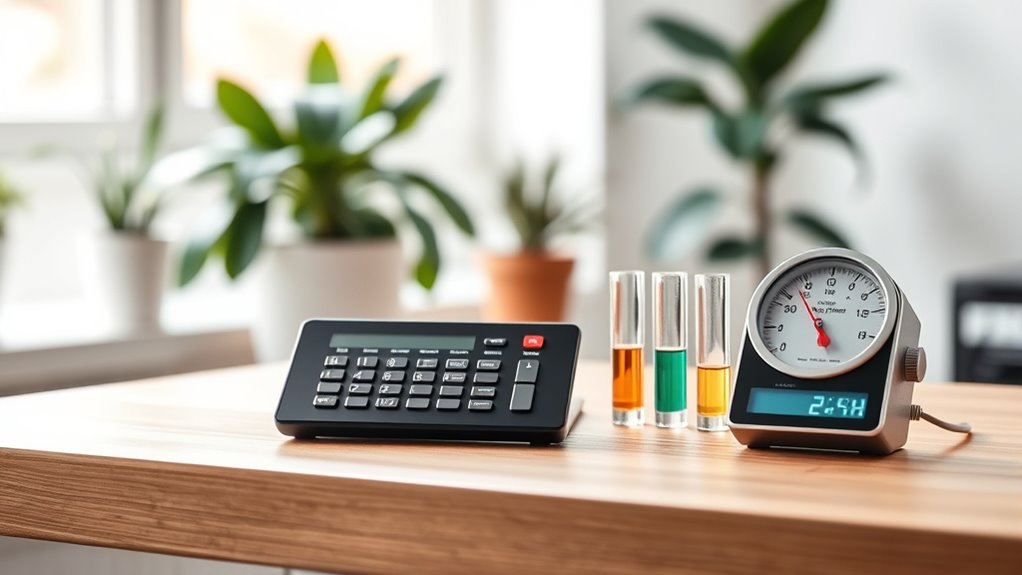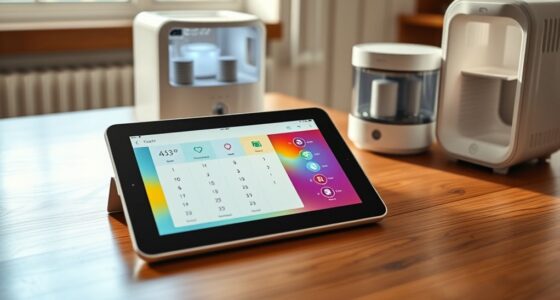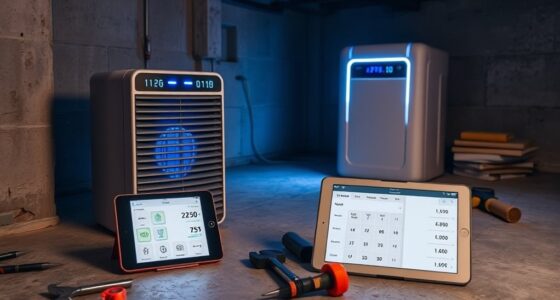An air exchange rate calculator helps you measure how often your indoor air is replaced with outside air, which is key for maintaining healthy, fresh environments. By inputting room size, occupancy, and ventilation details, you can see if your current setup meets recommended standards and identify areas for improvement. Proper ventilation reduces pollutants, moisture, and odors, boosting comfort and health. Keep exploring to discover how optimizing your ventilation can enhance your indoor air quality even further.
Key Takeaways
- An air exchange rate calculator measures how often indoor air is replaced, ensuring ventilation meets health and safety standards.
- It helps identify areas with inadequate airflow, allowing for targeted improvements to indoor air quality.
- Using the calculator enables comparison of current ventilation rates with recommended ACH standards.
- It supports optimizing HVAC and natural ventilation systems to maintain healthy, comfortable indoor environments.
- Regular assessment with the calculator promotes compliance, reduces pollutants, and enhances overall indoor air health.

An air exchange rate calculator helps you determine how often indoor air is replaced with outside air within a specific space. This tool is crucial for evaluating ventilation effectiveness, ensuring that your environment meets recommended ventilation standards, and maintaining healthy indoor air quality. When you know the air exchange rate, you can make informed decisions about ventilation systems, air filtration, and overall space management. Proper ventilation is essential because it directly impacts indoor air quality, which affects comfort, health, and productivity. For most residential and commercial spaces, adhering to ventilation standards is important. These standards are set by health and safety organizations to ensure that indoor environments are safe and comfortable. They specify minimum air exchange rates, often expressed as air changes per hour (ACH), to prevent the buildup of pollutants, moisture, and odors. When you use an air exchange rate calculator, it helps you determine whether your current ventilation system meets these standards or if adjustments are necessary. For example, a high ACH indicates frequent air replacement, which is beneficial for reducing airborne contaminants, whereas a low ACH might signal poor ventilation that could lead to stuffy, unhealthy indoor air. Knowing your space’s air exchange rate allows you to optimize your ventilation system, whether you’re managing a home, office, or industrial environment. It enables you to identify areas with inadequate airflow and take steps to improve it—such as upgrading your HVAC system, adding exhaust fans, or increasing natural ventilation. By doing so, you reduce the risk of indoor air pollution, which can cause respiratory issues, allergies, and other health problems over time. Additionally, improving indoor air quality through proper ventilation can enhance comfort levels and even boost productivity in workspaces. Using a calculator takes the guesswork out of ventilation planning. You input details like room dimensions, occupancy, and existing ventilation rates, and it provides a clear picture of your current air exchange rate. From there, you can compare your results with recommended ventilation standards and decide whether to increase outdoor air intake or implement additional air purification measures. This proactive approach ensures your indoor environment remains healthy and compliant with safety guidelines. Understanding air filtration and ventilation technology can further enhance your indoor air quality management.
Frequently Asked Questions
How Often Should I Recalibrate My Air Exchange Rate Calculator?
You should recalibrate your air exchange rate calculator at least once every six months to maintain calibration accuracy. Regular maintenance schedules help guarantee your readings stay precise, especially if you’ve moved to a different environment or notice discrepancies. If your usage is frequent or environmental conditions change markedly, consider recalibrating more often. Staying on top of calibration helps you optimize ventilation effectively for healthier indoor air quality.
Can the Calculator Account for Different Room Occupancy Levels?
Yes, your calculator can account for different room occupancy levels by adjusting for occupant density, which influences ventilation needs. It considers ventilation standards to guarantee proper air quality based on how crowded the space is. By inputting the number of occupants, you can optimize ventilation rates to meet safety and health guidelines. This helps maintain healthy air quality regardless of changes in room occupancy, ensuring a safe environment.
Is the Calculator Suitable for Commercial or Industrial Spaces?
Yes, the calculator suits commercial applications and meets industrial requirements. You can easily adapt it to large, complex spaces, guaranteeing proper ventilation and air quality. It helps you meet safety standards, optimize airflow, and manage occupancy levels effectively. By customizing parameters, you ensure healthy indoor environments, whether for offices, factories, or warehouses. This tool empowers you to maintain compliance and promote well-being across various commercial and industrial settings.
How Does Outdoor Air Quality Affect Ventilation Calculations?
Outdoor air quality considerably impacts your ventilation calculations because outdoor pollution and air quality metrics directly influence how much fresh air you need to bring inside. If outdoor pollution levels are high, you’ll need to adjust ventilation rates to minimize indoor contaminants while still providing healthy air. Monitoring outdoor air quality metrics helps you optimize your ventilation system, ensuring indoor air remains clean without over-ventilating and wasting energy.
Can It Help Identify the Most Energy-Efficient Ventilation Options?
Think of the calculator as your compass in a forest of options. It helps you find the most energy-efficient ventilation solutions by highlighting which setups maximize airflow with minimal energy use. With ventilation optimization, you can balance air quality and energy savings, ensuring your space stays healthy and cost-effective. This tool guides you to smarter choices, making your ventilation system both effective and eco-friendly.
Conclusion
By using the air exchange rate calculator, you guarantee healthier air, safer spaces, and better well-being. You control the airflow, you improve the environment, and you protect those around you. With each calculation, you make smarter choices, create fresher rooms, and foster comfort. Remember, ventilation is your tool, awareness is your power, and health is your goal. Take charge, optimize your air, and breathe easier—because a better environment begins with you.









